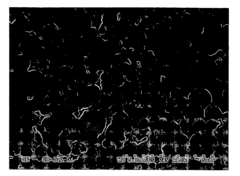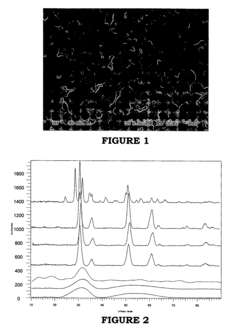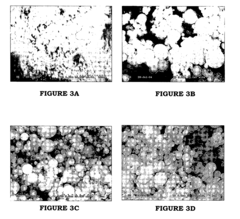Zirconia in Hydrogen Production: Efficiency Improvements
Zirconia H2 Production Background and Objectives
Zirconia has emerged as a promising material in the field of hydrogen production, attracting significant attention from researchers and industry professionals alike. The development of zirconia-based technologies for hydrogen production has its roots in the broader context of clean energy initiatives and the global push towards sustainable fuel sources. Over the past few decades, the evolution of zirconia applications in this domain has been driven by the increasing demand for efficient and cost-effective hydrogen production methods.
The technological trajectory of zirconia in hydrogen production has been marked by continuous improvements in material properties, process design, and system integration. Initially, zirconia was primarily utilized as a support material for catalysts in steam reforming processes. However, as research progressed, its potential as an active component in electrolysis and thermochemical cycles became apparent, leading to a shift in focus towards these more advanced applications.
The current landscape of zirconia-based hydrogen production technologies encompasses a wide range of approaches, including solid oxide electrolysis cells (SOECs), thermochemical water splitting cycles, and membrane reactors. Each of these methods leverages the unique properties of zirconia, such as its high ionic conductivity, thermal stability, and chemical resistance, to enhance the efficiency and durability of hydrogen production processes.
As we look towards the future, the primary objective in this field is to significantly improve the efficiency of zirconia-based hydrogen production systems. This overarching goal encompasses several key areas of focus, including:
1. Enhancing the electrochemical performance of zirconia-based materials in SOECs to reduce energy input requirements and increase hydrogen yield.
2. Optimizing the thermochemical properties of zirconia for improved cyclability and stability in high-temperature water splitting processes.
3. Developing novel composite materials that combine zirconia with other functional components to create synergistic effects and overcome existing limitations.
4. Refining manufacturing techniques to produce zirconia-based components with precise microstructures and tailored properties for specific hydrogen production applications.
5. Integrating zirconia-based technologies into larger energy systems to maximize overall efficiency and enable seamless coupling with renewable energy sources.
By addressing these objectives, researchers and engineers aim to position zirconia as a key enabler in the transition towards a hydrogen-based economy. The ultimate goal is to develop zirconia-based hydrogen production technologies that are not only highly efficient but also economically viable and environmentally sustainable on a large scale.
Hydrogen Market Demand Analysis
The global hydrogen market is experiencing significant growth, driven by the increasing demand for clean energy solutions and the push towards decarbonization. As countries and industries seek to reduce their carbon footprint, hydrogen has emerged as a promising alternative fuel source, particularly in sectors that are difficult to electrify directly.
In the transportation sector, hydrogen fuel cell vehicles are gaining traction, especially for long-haul trucking, buses, and material handling equipment. The automotive industry is investing heavily in hydrogen technology, with major manufacturers developing and launching fuel cell vehicles. This trend is expected to continue, potentially leading to a substantial increase in hydrogen demand for mobility applications.
The industrial sector represents another major area of potential growth for hydrogen consumption. Steel production, chemical manufacturing, and refining processes are exploring hydrogen as a means to reduce emissions and improve efficiency. Green hydrogen, produced through electrolysis using renewable energy, is particularly attractive for industries aiming to achieve carbon neutrality.
Energy storage and grid balancing applications are also driving hydrogen demand. As renewable energy sources like wind and solar become more prevalent, the need for long-term energy storage solutions increases. Hydrogen can be produced during periods of excess renewable energy generation and stored for later use, providing a valuable tool for grid stability and energy security.
In the heating sector, blending hydrogen with natural gas in existing pipeline networks is being explored as a way to reduce carbon emissions without requiring significant infrastructure changes. Some countries are even considering the development of dedicated hydrogen networks for residential and commercial heating applications.
The maritime industry is another emerging market for hydrogen, with ships and ports exploring hydrogen-based solutions to meet stringent emissions regulations. Hydrogen fuel cells and hydrogen-derived fuels like ammonia are being considered for powering large vessels and providing shore power.
Market projections indicate substantial growth in the hydrogen economy over the coming decades. While specific figures vary depending on the source and assumptions made, most analysts agree that the hydrogen market could see a compound annual growth rate (CAGR) in the double digits through 2030 and beyond. This growth is expected to be particularly strong in regions with ambitious climate targets and supportive policy frameworks, such as the European Union, Japan, and South Korea.
Zirconia Technology Status and Challenges
Zirconia has emerged as a promising material in hydrogen production, particularly in high-temperature electrolysis processes. The current status of zirconia technology in this field shows significant advancements, yet it also faces several challenges that need to be addressed for wider adoption and improved efficiency.
One of the primary applications of zirconia in hydrogen production is its use as an electrolyte in solid oxide electrolysis cells (SOECs). Yttria-stabilized zirconia (YSZ) is widely used due to its excellent ionic conductivity at high temperatures. However, the high operating temperatures required for optimal performance (typically above 800°C) pose challenges in terms of material degradation and system durability.
Recent research has focused on developing zirconia-based composites and nanostructured materials to enhance ionic conductivity and reduce operating temperatures. For instance, scandia-stabilized zirconia (ScSZ) has shown promise in lowering the operating temperature while maintaining high ionic conductivity. Despite these advancements, further improvements in ionic conductivity at intermediate temperatures (600-800°C) are still needed to enhance overall system efficiency and reduce costs.
Another significant challenge is the mechanical stability of zirconia-based components under the harsh operating conditions of hydrogen production systems. Thermal cycling and chemical reactions can lead to degradation of the material over time, affecting long-term performance and reliability. Researchers are exploring various strategies to mitigate these issues, including the development of composite materials and protective coatings.
The scalability of zirconia-based technologies for large-scale hydrogen production remains a critical challenge. While laboratory-scale demonstrations have shown promising results, translating these successes to industrial-scale applications requires overcoming issues related to manufacturing processes, cost-effectiveness, and system integration.
Geographically, research and development in zirconia technology for hydrogen production are concentrated in regions with strong renewable energy initiatives and hydrogen economy goals. Countries like Japan, Germany, and the United States are at the forefront of this technology, with significant investments in research institutions and industrial collaborations.
In conclusion, while zirconia technology has made substantial progress in improving hydrogen production efficiency, several challenges persist. These include optimizing performance at lower temperatures, enhancing long-term stability, and scaling up for industrial applications. Addressing these challenges will be crucial for the widespread adoption of zirconia-based technologies in the hydrogen production sector.
Current Zirconia H2 Production Solutions
01 Zirconia-based solid electrolytes for fuel cells
Zirconia-based materials are used as solid electrolytes in fuel cells due to their high ionic conductivity and stability at high temperatures. These electrolytes improve the efficiency of fuel cells by facilitating the transport of oxygen ions. The composition and structure of zirconia-based electrolytes can be optimized to enhance their performance and durability in fuel cell applications.- Zirconia-based solid electrolytes for fuel cells: Zirconia-based materials are used as solid electrolytes in fuel cells due to their high ionic conductivity and stability at high temperatures. These electrolytes improve the efficiency of fuel cells by facilitating the transport of oxygen ions. The composition and structure of zirconia-based electrolytes can be optimized to enhance their performance and durability in fuel cell applications.
- Zirconia in dental applications: Zirconia is widely used in dental applications due to its excellent mechanical properties and biocompatibility. It is used to create dental crowns, bridges, and implants. The efficiency of zirconia in dental applications is related to its high strength, wear resistance, and aesthetic appearance. Advanced manufacturing techniques are employed to improve the precision and performance of zirconia-based dental products.
- Zirconia as a catalyst support: Zirconia is utilized as a catalyst support in various chemical processes due to its high surface area, thermal stability, and ability to enhance catalytic activity. The efficiency of zirconia as a catalyst support can be improved by controlling its crystal structure, surface properties, and porosity. This leads to increased catalytic performance and longevity in industrial applications.
- Zirconia in thermal barrier coatings: Zirconia is used in thermal barrier coatings to improve the efficiency and durability of high-temperature components in gas turbines and aerospace applications. The low thermal conductivity and high thermal expansion coefficient of zirconia make it an ideal material for protecting underlying metal substrates from extreme temperatures. Advanced deposition techniques and compositional modifications are employed to enhance the performance of zirconia-based thermal barrier coatings.
- Zirconia nanoparticles for enhanced efficiency: Zirconia nanoparticles are utilized in various applications to improve efficiency and performance. These nanoparticles can enhance the mechanical, optical, and chemical properties of materials. The size, shape, and surface characteristics of zirconia nanoparticles can be tailored to optimize their efficiency in specific applications, such as in advanced ceramics, coatings, and composite materials.
02 Zirconia in dental applications
Zirconia is widely used in dental applications due to its excellent mechanical properties and biocompatibility. It is used to create dental crowns, bridges, and implants with high efficiency and durability. The material's strength and aesthetic qualities make it an ideal choice for restorative dentistry, improving the longevity and appearance of dental prosthetics.Expand Specific Solutions03 Zirconia-based catalysts for chemical processes
Zirconia is utilized as a catalyst or catalyst support in various chemical processes, enhancing reaction efficiency and selectivity. Its high surface area, thermal stability, and ability to be modified with other elements make it valuable in catalytic applications. Zirconia-based catalysts are used in processes such as hydrogenation, dehydrogenation, and isomerization reactions.Expand Specific Solutions04 Zirconia in thermal barrier coatings
Zirconia is an essential component in thermal barrier coatings used to protect metal components in high-temperature environments, such as gas turbine engines. These coatings improve the efficiency and longevity of the components by reducing heat transfer and protecting against oxidation and corrosion. The structure and composition of zirconia-based coatings can be optimized to enhance their thermal insulation properties.Expand Specific Solutions05 Zirconia in oxygen sensors
Zirconia is used in oxygen sensors, particularly in automotive applications, to measure and control the air-fuel ratio in engines. These sensors utilize zirconia's oxygen ion conductivity to generate a voltage signal proportional to the oxygen concentration. The efficiency of zirconia-based oxygen sensors contributes to improved engine performance, fuel economy, and reduced emissions.Expand Specific Solutions
Key Players in Zirconia-based H2 Production
The hydrogen production industry utilizing zirconia technology is in a growth phase, with increasing market size driven by the global push for clean energy solutions. The market is characterized by a mix of established chemical companies and emerging technology firms, indicating a competitive landscape with diverse players. Companies like Sumitomo Chemical Co., Ltd., China Petroleum & Chemical Corp., and Air Liquide SA are leveraging their extensive resources and expertise to advance zirconia-based hydrogen production efficiency. Technological maturity varies, with ongoing research and development efforts by entities such as Toyota Motor Corp. and Johnson Matthey Plc focusing on improving catalyst performance and process optimization. The involvement of academic institutions and research foundations suggests a dynamic environment for innovation and potential breakthroughs in efficiency improvements.
Air Liquide SA
Toyota Motor Corp.
Key Zirconia H2 Production Innovations
- A process involving the addition of a zirconium precursor to a precipitation agent, followed by digestion and spray drying to form high surface area amorphous zirconia, which is then calcined to produce a zirconia product comprising at least 99.9% tetragonal phase, with optional addition of surfactants, morphology enhancing agents, and metal precursors to enhance surface area and stability.
- A process involving the calcination of a zirconium salt in an atmosphere containing hydrogen chloride, where pre-calcining and subsequent calcination in a hydrogen chloride atmosphere produce fine zirconia powder without the need for a hydrolyzing step, using zirconium oxychloride, zirconium nitrate, or zirconium sulfate as starting materials, and optionally incorporating a seed crystal to control particle diameter.
Environmental Impact Assessment
The environmental impact assessment of zirconia in hydrogen production efficiency improvements is a critical aspect of evaluating the overall sustainability and viability of this technology. Zirconia-based materials have shown promising potential in enhancing hydrogen production processes, particularly in high-temperature electrolysis and thermochemical water splitting. However, their implementation must be carefully examined from an environmental perspective.
One of the primary environmental benefits of using zirconia in hydrogen production is the potential reduction in energy consumption. By improving the efficiency of electrolysis processes, zirconia-based electrodes can lead to decreased electricity usage, thereby indirectly reducing greenhouse gas emissions associated with power generation. This is especially significant in regions where the electricity grid relies heavily on fossil fuels.
The durability and longevity of zirconia materials also contribute to their environmental profile. Compared to traditional electrode materials, zirconia-based components often exhibit superior resistance to degradation under harsh operating conditions. This extended lifespan translates to reduced material replacement frequency, minimizing waste generation and the environmental impacts associated with manufacturing and disposing of electrode materials.
However, the production of zirconia itself requires careful consideration. The mining and processing of zirconium ores can have significant environmental impacts, including habitat disruption, water pollution, and energy-intensive refining processes. Life cycle assessments are necessary to quantify these upstream impacts and compare them with the environmental benefits gained during hydrogen production.
Water consumption is another crucial factor to evaluate. While zirconia-based systems may improve the efficiency of water electrolysis, the overall water footprint of hydrogen production remains a concern, especially in water-stressed regions. Advancements in water recycling and the use of non-potable water sources should be explored in conjunction with zirconia technology improvements.
The potential for material recovery and recycling at the end of the zirconia components' life cycle is an important consideration. Developing efficient recycling processes for spent zirconia electrodes could significantly reduce the environmental burden associated with raw material extraction and waste disposal.
Lastly, the environmental impact assessment must consider the broader implications of increased hydrogen production enabled by zirconia-based efficiency improvements. While hydrogen is often touted as a clean energy carrier, its large-scale production and utilization infrastructure must be developed sustainably to realize its full environmental benefits.
Economic Feasibility Analysis
The economic feasibility of implementing zirconia-based technologies for hydrogen production efficiency improvements is a critical consideration for industry stakeholders. The initial capital investment for zirconia-based systems can be substantial, primarily due to the high costs associated with material procurement and specialized manufacturing processes. However, these upfront expenses must be weighed against the potential long-term benefits and cost savings.
One of the key economic advantages of zirconia in hydrogen production is its ability to enhance efficiency, potentially leading to reduced energy consumption and lower operational costs. The improved durability and thermal stability of zirconia-based components can result in extended equipment lifespans, reducing the frequency and costs of replacements and maintenance. This longevity factor contributes significantly to the overall economic viability of the technology.
The scalability of zirconia-based solutions is another crucial economic consideration. As production scales increase, the per-unit costs of zirconia components are likely to decrease, improving the economic feasibility for large-scale hydrogen production facilities. This economy of scale effect could make zirconia-based technologies increasingly attractive for industrial applications.
Market dynamics also play a vital role in the economic feasibility analysis. The growing demand for clean hydrogen as an energy carrier is expected to drive investment in more efficient production technologies. This trend could create a favorable economic environment for zirconia-based solutions, potentially accelerating their adoption and reducing costs through increased market competition and technological advancements.
The economic impact of improved hydrogen production efficiency extends beyond direct operational costs. Enhanced efficiency can lead to increased hydrogen output per unit of input, potentially improving profit margins for producers. Additionally, the environmental benefits associated with more efficient hydrogen production may translate into economic advantages through carbon credits or compliance with increasingly stringent environmental regulations.
When considering the economic feasibility, it is essential to account for the entire lifecycle costs of zirconia-based systems. This includes not only the initial investment and operational expenses but also end-of-life considerations such as recycling or disposal costs. The potential for recycling zirconia components could provide additional economic benefits and contribute to the circular economy, further enhancing the long-term economic viability of the technology.



